
About UsThe Numismatic Bibliomania Society is a non-profit organization promoting numismatic literature. For more information please see our web site at coinbooks.org SubscriptionsThose wishing to become new E-Sylum subscribers (or wishing to Unsubscribe) can go to the following web page link MembershipThere is a membership application available on the web site Membership Application To join, print the application and return it with your check to the address printed on the application. Membership is only $15 to addresses in the U.S., $20 for First Class mail, and $25 elsewhere. For those without web access, write to: David M. Sundman, Secretary/TreasurerNumismatic Bibliomania
Society AsylumFor Asylum mailing address changes and other membership questions, contact David at this email address: dsundman@LittletonCoin.com SubmissionsTo submit items for publication in The E-Sylum, just Reply to this message, or write to the Editor at this address: whomren@coinlibrary.com
BUY THE BOOK BEFORE THE COINYou won't regret it! |
- WAYNE'S WORDS: THE E-SYLUM AUGUST 28, 2011
- NUMISMATIC LITERATURE EXHIBITS AT THE 2011 CHICAGO ANA
- MORE ON THE WHITMAN BLACK BOOK SERIES
- NOTES FROM E-SYLUM READERS: AUGUST 28, 2011
- QUERY: HOW WAS GOLD ALASKA PURCHASE CENTENNIAL TRADE DOLLAR STRUCK?
- MORE ON THE ALASKA STATEHOOD MEDAL
- NUMISMATIC PERSONALITIES ON "WHAT'S MY LINE"
- MORE ON THE TYPE II QUINT
- MORE ON COL. WALTER CUTTING OF PITTSFIELD, MASSACHUSETTS
- THE NUMISMATIC AND ANTIQUARIAN SERVICE CORPORATION OF AMERICA
- GENUINE ELECTROTYPE: PCGS CERTIFIES UNIQUE COPY OF A UNIQUE 1804 DOLLAR
- BUSINESSWEEK ARTICLE ON THE 1933 DOUBLE EAGLE
- DICK JOHNSON: ALUMINIZED-STEEL NOT A VIABLE CENT ALLOY
- WAYNE'S NUMISMATIC DIARY: AUGUST 28, 2011
- THE ORDER OF THE STRIPED TIGER
- THE PRIEST AND THE UNLOVED COINS
- ARTICLE HIGHLIGHTS SAN FRANCISCO HOTEL'S MONEY LAUNDERER
- THE ORIGIN OF THE TREVI FOUNTAIN COIN TRADITION
- FEATURED WEB PAGE: EARLY QUARTER DOLLARS OF THE UNITED STATES 1796-1838
WAYNE'S WORDS: THE E-SYLUM AUGUST 28, 2011

Among our new subscribers this week are Christopher Buck and Craig Eberhart. Welcome aboard! We have 1,452 email subscribers, plus 157 followers on Facebook, including Mile Kocev.
This week we open with the exhibit winners in the Numismatic Literature class at last week's ANA convention, and more on the Whitman "black book" series. Other topics include numismatic personalities on "What's My Line?", the Type II Quint, NASCA, and a slabbed 1804 dollar electrotype.
To learn more about an awesome book dude, a rare coin with talismanic powers, the D.C. earthquake devastation, coin laundering and the Trevi Fountain coin toss tradition, read on. Have a great week, everyone!
NUMISMATIC LITERATURE EXHIBITS AT THE 2011 CHICAGO ANA
Class 17: Numismatic Literature – Aaron Feldman Memorial.
First Place: George Kolbe, "Numismatic Bibliography 1579-1912: The Literature of Numismatic Literature"
Second Place: Lawrence Sekulich, "Paul Manship's Book for the Circle of Friends of the Medallion."
George Kolbe adds:
I greatly enjoyed putting together my exhibit and would encourage other numismatic bibliophiles and researchers to do so in the future. The exhibit personnel, particularly Paul Hybert, were capable, cooperative, friendly, and quite encouraging to a first time exhibitor, as were the exhibit judges and a number of other exhibitors.
I have long opined that the joy of numismatic collecting is most clearly expressed at ANA summer seminars; now I would add the annual exhibit program as a close second.
To read a list of past winners, see the NBS web site: Numismatic Literature Exhibits (coinbooks.org/about/exhibit_winners.html)
MORE ON THE WHITMAN BLACK BOOK SERIES
Ken Bressett writes:
Regarding the Whitman Black Books. I edited and published them all. The list that you have is complete. They sold for about $1 each at the time, with press runs of 10,000 for most of them.
Neil Shafer writes:
On the question of the Whitman dollar series of little black books, the number of basic titles is indeed 13, but there are still some additions to include if you want to be technically complete.
For Slabaugh's Confederate States Paper Money, there were three distinctly separate books. The first was published in 1958. There was a Second Edition with publication date of 1959. The Third and last edition had a different cover design with same basic title but with a Stars-and-Bars design underneath and words "Centennial Edition", published in 1961.
The Hawaiian Coins, Tokens and Paper Money book of Gould (without Bressett) was published in 1960. The dual authorship version came out in 1961 as a Second Revised Edition. A small correction in a title: there is no "The" in "Foreign Coins Struck At United States Mints."
John Mutch writes:
On the Whitman Black Books, in addition to the Hawaiian Coins, Tokens and Paper Money by Maurice M. Gould and Kenneth Bressett listed, which in my copy is shown as "Second Revised Edition" dated 1961, I have a (water damaged) Hawaiian Coins, Tokens and Paper Money By Maurice M. Gould, dated 1960. This original one has 45 numbered pages whereas the 1961 version has 48.
Fred Lake writes:
I have the attached file from one of our sales (Feb, 1999, I think) that lists a complete set. You will see that there are thirteen titles in eighteen editions. I believe the lot sold for $150.00 back then.
WHITMAN PUBLISHING-1958 to 1965-this lot contains all 18 of the so-called "Whitman Black Books". Each subject, author and edition is included. Some of the editions are rather scarce and the storehouse of knowledge contained in these pages is remarkable. Here is an opportunity to acquire a complete set of these marvelous little books. Thus you will be acquiring thirteen titles in eighteen editions.
ALTZ, C.and BARTON, E.-1965-"Foreign Coins Struck at United States Mints"-63pp,ills,black flex-card covers,gilt,12mo.
DAVENPORT, John S.-1959-"The Silver Dollars of Africa"-42 pages, illustrations, valuations,black flex-card covers,gilt,12mo.
DODSON, O.H.-1962-"Money Tells the Story"-64pp,ills,black flexcard covers,12mo.
 FULD, George & Melvin-
1960-First Edition-"Patriotic Civil War
Tokens"-77pp,22pls,black flex-card covers,12mo.
FULD, George & Melvin-
1960-First Edition-"Patriotic Civil War
Tokens"-77pp,22pls,black flex-card covers,12mo.
1960-Second Revised Edition-"Patriotic Civil War Tokens"- 77pp,22pls,ills,rarity scale, black flex-card covers,12mo.
1965-Whitman-Third Rev. Edit.-"Patriotic Civil War Tokens"- 77pp,22 pls,black flex-card covers,12mo.
1962-"A Guide to Civil War Store Card Tokens"-96pp,ills,rarity scales, black flex-card covers,12mo.
GOULD, Maurice M.-1960-"Hawaiian Coins, Tokens and Paper Money"- 45pp,pls,ills,black flex-card covers,gilt,12mo.
GOULD, Maurice and BRESSETT,Ken-1960-"Alaska's Coinage Through the Years"-46pp, ills,black flex-card covers,12mo.
GOULD, Maurice & BRESSETT,Ken-1961-Second Edition-"Hawaiian Coins, Tokens and Paper Money"-48pp,ills,flex-card covers,gilt,12mo.
GOULD, Maurice and HIGGIE, Lincoln W.-1962-"The Money of Puerto Rico"-83pp,ills,vals,black flex-card covers,12mo.
HIGGIE, Lincoln W.-1962-"The Colonial Coinage of the U.S. Virgin Islands"-61pp,ills,black flex-card covers,12mo.
ROTHERT, Matt-1963-"A Guide Book of United States Fractional Currency"-81pp,ills,black flex-card covers,gilt,12mo.
SHAFER, Neil-1961-"United States Territorial Coinage for the Philippine Islands"-63pp,ills, black flex-card covers,12mo.
SLABAUGH, Arlie-1958-"Confederate States Paper Money",48pp, ills,valuations,black flex-card covers,12mo.
SLABAUGH, Arlie-1959-2nd Edition-"Confederate States Paper Money"-48pp,ills,valuations,black flex-card covers,12mo.
SLABAUGH, Arlie-1961(Centennial Edition)-"Confederate States Paper Money"-48pp,ills,valuations,black flex-card covers,12mo.
YEOMAN,R.S.-1961-"Moneys of the Bible"-61pp,ills,black flex-card covers,12mo
To read the earlier E-Sylum article, see: QUERY: THE WHITMAN BLACK BOOK SERIES (www.coinbooks.org/esylum_v14n35a04.html)
THE BOOK BAZARRE
NOTES FROM E-SYLUM READERS: AUGUST 28, 2011
On Striking Coins Outside the U.S. Mints
Dick Hanscom writes:
On U.S. minting facilities: When the U.S. Mint sent a representative to Anchorage to meet with commission that helped design the Alaska quarter, I suggested that they strike some at the Alaska Mint ( a private mint with which I have no legal connection – we do buy their product). The lady was not amused, and did not take my suggestion seriously. She had no idea how serious I was!
To read the earlier E-Sylum article, see: E-SYLUM'S BEST: HOW MANY DIFFERENT MINT BUILDINGS?" (www.coinbooks.org/esylum_v14n32a05.html)
Pete Smith's Chicago ANA Convention Notes
Pete Smith writes:
Before leaving for the ANA convention, my boss lamented that he really did not want to go. With the current level of business in his shop, he could make more money staying at home. We left one of our staff back in the office and he called us to say business was like it was back in 1980.
I will comment of Alan Weinberg's statement that no one was buying bullion gold or silver. During the show we got an order from a client and picked up a thousand ounces of silver from SilverTowne. That was not really an ANA transaction. If we had been at home, the same deal could have been arranged through the mail.
On several occasions, I saw characters from Star Wars wandering the floor of the convention center. I suspect they came in for the earlier Comicon convention and lost their transporter rides home. I could see no connection between them and numismatics.
To read the earlier E-Sylum article, see: WAYNE'S NUMISMATIC DIARY: AUGUST 21, 2011 (www.coinbooks.org/esylum_v14n35a13.html)
Alan Weinberg's Chicago ANA Convention Notes
Alan V. Weinberg writes:
Here are a few more observations I made at the Chicago ANA:
While a relatively minor negative about the show, this was a particular irritant thruout the show: the extremely loud and all-too-frequent public address system which interrupted any form of business transaction or conversation while it blasted. In many decades of ANA attendance, I do not recall the PA system being quite so loud or so obtrusive. I did notice that almost everyone around me, while the PA system blasted, was similarly irritated and had to stop what they were saying or doing.
Heritage proudly exhibited some just- arrived notable auction consignments, some of which literally knocked me for a loop. John Adams - formerly a diehard consignor to Stack's and Bowers & Merena/ANR with his 1794 coppers and his Indian Peace medals, etc - has consigned to Heritage the first segment of his remarkable Betts Early American history medal collection for the January NYC International show- to be catalogued I understand by John Kraljevich according to Heritage's Mark Borckardt, who wisely knows his limitations as this is a very difficult series to catalogue . Certainly an esoteric group of medals but with many great rarities and the forerunner of the rest of Adams' Betts medal collection including his remarkable Comitia Americana medals.
And Denis Loring has consigned most of his 1793 Chain and Wreath cents, a remarkably choice EF and AU grouping (just the way most of us like 'em- lightly circulated but still relatively "affordable"), for Heritage's Jan FUN Orlando auction. Denis is keeping a type set of 1793's but the rest of the coins have been off the market for well over a decade. I've seen them raw "in hand" at an early EAC in Ky - they're now necessarily slabbed (sob!) - and they are notable for their immaculate surfaces and rims.
New York Coin dealer Killed
Ursula Kampmann and Alan Weinberg forwarded article about the killing of a New York coin dealer. Here's an update on the story from New York Post:
A man was arrested on Staten Island yesterday for the murder of a coin dealer in Brooklyn, cops said. Cops caught Andrew Jackson, 26, by using fingerprints he left on the car where his victim was beaten to death, said a law enforcement source.
Jackson and two other violent crooks allegedly dragged numismatist Steve Halfon, 61, out of his car near his coin shop on Kings Highway in Gravesend at 5:10 p.m. Tuesday.
They threw Halfon into another vehicle, where they beat him savagely. The vicious gang later dumped an unconscious Halfon about a mile away on East 7th Street near Avenue N in Midwood, less than two blocks from Halfon's home.
To read the complete article, see:
Coin killer nabbed: cops
(www.nypost.com/p/news/local/staten_island/coin_killer
_nabbed_cops_Yem0GaVYbaPzgDT4WbCr1H)
Generating Coin Hobby Publicity
Dick Johnson writes:
Coin dealers are notorious poor promoters. If you own a coin shop drop an email to the city editor of your local newspaper. Mention something newsworthy like you are getting an increasing number of first time coin buyers -- of investment coins, bullion coins of gold and silver.
See how fast the city editor will send a reporter! That's news in this economy.
Here's an exceptionally fine article from Chico Nevada of local coin dealer John Kranz, just published this week. Short article, nice photo, highly readable throughout. Excellent example.
To read the complete article, see: A penny for his thoughts (www.newsreview.com/chico/penny-for-his-thoughts/content?oid=3361928)
QUERY: HOW WAS GOLD ALASKA PURCHASE CENTENNIAL TRADE DOLLAR STRUCK?
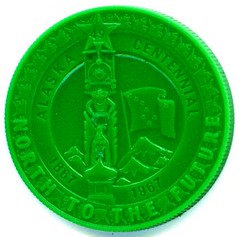
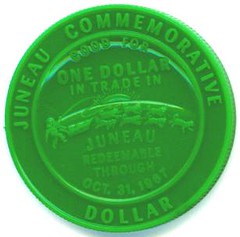
Here is a puzzler for The E-Sylum. Scans are attached. Background – two different sets of three different colored plastic "trade dollars" were issued for the Alaska Purchase Centennial in 1967. One set for Juneau (yellow, green and dark blue), one for Anchorage (red, white and light blue).
Consigned to our Sept. 24 auction are two pieces from the Juneau issue, one in lead and one in what appears to be 18kt gold (specific gravity is 15.22). The lead is well cast/struck and appears to be two halves (quite thick) put together. The detail is as good as on the plastic.
The gold is very weak. It appears to have been turned down (by the marks on the edge) from a larger piece of gold. It is not two pieces put together as it rings as a solid piece. It may not be unique, but is definitely the last as the die/mold is collapsing. There is a die break all around the central ring, and the central portion is raised rather than dished as on the lead and plastic. There are also multiple other die breaks.
So I guess my question is this: How does one use molds (dies?) used for casting plastic to "strike" gold?
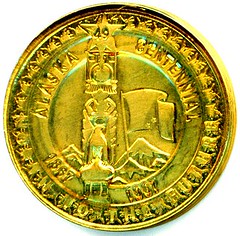
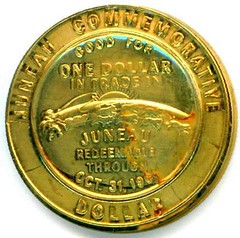
MORE ON THE ALASKA STATEHOOD MEDAL
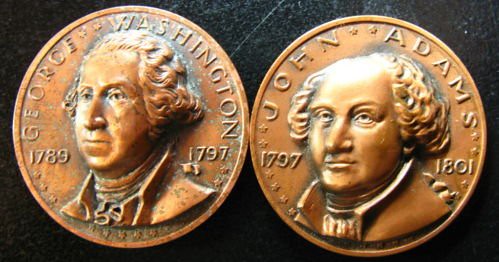

First off, thank you for your many contributions to a thoroughly fascinating on-line publication. Whenever I wish to avoid actually doing my day job I can always count on The E-Sylum to provide an interesting if not outright enjoyable way to procrastinate.
As avid collectors of all things round and metal and Alaskan and dated between our Statehood in '59 and our Centennial in '67 (wheh!) my wife and I were very interested by the reply to our friend and fellow collector's inquiry regarding one of our more mysterious commemoratives, that being President Adam's portrait on a medal bearing our state's seal:
The answer, learned as it is, still left some doubt in our minds. As for it possibly being a "mule" however, my wife's find of a silver edge-numbered specimen in the 800's took much from the credibility of that being a possibility, as did the subsequent discovery of bronze versions.
For the record, the producer was Metal Arts Company (and not MACO, as is most often reported) who's president, John L Jack, died this past January 5th. His obituary noted his time spent in the Navy and, perhaps far more importantly here, was quite careful to point out he had "served in Alaska".
While we do not know if he was yet president of Metal Arts at the time the Adams/Alaska was minted, if so his desire to honor the state he called home is certainly likely. Further, as he undoubtedly travelled the Pacific it is also likely he would have stopped off in Hawaii as well, thus possibly also providing some inclination to honor our 50th state as well.
All of which brings us to the recent find (on eBay, where else?) of the pair of medals in the attached photos. These photos lead us to believe the Adams/Alaska coin was minted as part of a two-coin Hawaii/Alaska set. This combination was exceedingly common. For example, there is the SOM Alaska/Hawaii Medallion, the MACO "Official" Alaska and Hawaii companion medallions, Mishler's Alaska/Hawaii set, G&G Distributors "Flag Day" Dollars and Heraldic Arts Alaska and Hawaii "Halves", not to mention the Franklin Mint's many subsequent and shameless attempts.
All that said, while we are very proud and pleased that documented historical connections do exist between John Adams and the State of Alaska we would have to say the existence of a Washington/Hawaii set pretty much changes the debate as to why an Alaska/Adams was actually produced. Our guess would be that Metal Arts simply wished to cash in on the Alaska/Hawaii medal frenzy, especially if they happened to already have at least the start of a Presidential Series on hand to work with.
Obviously, it would not be possible to match up the then (and now, Mr. President!) 50 states with the then 34 presidents (no, not even in reverse order…) so further installments could not have been contemplated. Additionally, I have never seen any other president's portrait on any medal of this size issued by Metal Arts.
I'm not sure if the Adams/Alaska medal nor its history is of any interest to collectors outside of Alaska, but at the very least we believe this discovery serves as yet another example of how a perfectly good theory can be brought into question by a single dose of reality.
To read the earlier E-Sylum article, see: WHY PRESIDENT JOHN ADAMS IS DEPICTED ON AN ALASKA STATEHOOD MEDAL (www.coinbooks.org/esylum_v12n16a18.html)
NUMISMATIC PERSONALITIES ON "WHAT'S MY LINE"
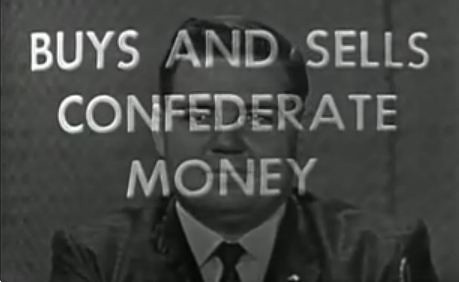
Here's something that might be a fun diversion for The E-Sylum. My fiancée and I enjoy old game shows, in particular "What's My Line" with John Daly. The show has had folks from all walks of life and all sorts of unusual occupations all the way up to luminaries such as Eleanor Roosevelt, Salvadore Dali and Frank Lloyd Wright. I was pleased to learn that four folks with rather prominent numismatic connections appeared on the show as contestants for the panel to guess their line of work. Below are links to four clips on YouTube that folks may enjoy watching:
Ivy Baker Priest (Treasurer of the United States) - originally aired on 29 August 1954. I like the fact that they had to blindfold the panel because they would no doubt recognize her signature:
www.youtube.com/watch?v=X3NmcP8tpXU
William H. Brett (Director of the United States Mint) - originally aired on 25 November 1956:
www.youtube.com/watch?v=cRa4jRvweog
J. A. Conlon (head of the Bureau of Engraving and Printing) - originally aired on 23 August 1959. He even brought samples:
www.youtube.com/watch?v=wWN2V84D_Hg
Finally, Col. Grover Criswell - originally aired 21 June 1959. He, too, brought samples, plus he brought a $1000 Montgomery note:
www.youtube.com/watch?v=HU6CJ2jKNEE
KOLBE & FANNING SEPTEMBER 15, 2011 SALE HIGHLIGHTS
Rare and Unusual Publications on American Numismatics Including
The 1909 Consul Weber Roman Sale and the Famous 1896 Montagu sale of Roman Gold George C. Perkins's Original Plated 1907 Stickney and 1912 Earle Chapman Sales A long run of Sylloge Nummorum Graecorum volumes
Catalogue Available at Our Web Site: www.numislit.com
Printed Catalogues $10.00
KOLBE & FANNING NUMISMATIC BOOKSELLERS
141 W JOHNSTOWN ROAD, GAHANNA OH 43230-2700
(614) 414-0855 • df@numislit.com • GFK@numislit.com
MORE ON THE TYPE II QUINT
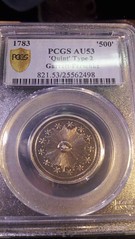 As previously noted in articles on the Nova Constellatio pattern coins, there are two 500 unit silver quint coins. The unique Type II Quint was displayed at Bill Burd's table at the Chicago ANA convention last week.
-Editor
As previously noted in articles on the Nova Constellatio pattern coins, there are two 500 unit silver quint coins. The unique Type II Quint was displayed at Bill Burd's table at the Chicago ANA convention last week.
-Editor
Tom DeLorey writes:
Apropos Walter Perschke's "Quint" piece, I got the chance to examine it raw on Thursday morning at the ANA. I noticed that there was something engraved above the "500" denomination. He said it was "5 Dec", which he assumed referred to the date December 5th, and perhaps signified the date on which it had been presented.
I suggested that it might refer to "5 Dec(imes)," another way of expressing the 500/1,000th denomination. He said that he had never considered the possibility.
Does anybody know if this possible explanation has been discussed elsewhere?
I don't recall having read anything about this notation before. I regret now not getting an image of the other side of the coin, but I doubt my smartphone camera would have picked up that detail. It was a little hard to see since the coin had already been slabbed by the time I got to view it, but I agree with Tom that it looks like "Dec 5". I like Tom's "5 decimes" explanation, but have no basis for believing it any more than the "December 5" explanation. What do readers think? -Editor
To read the earlier E-Sylum articles, see:
1783 NOVA CONSTELLATIO PATTERN COINS ON DISPLAY AT 2011 CHICAGO ANA
(www.coinbooks.org/esylum_v14n34a08.html)
WAYNE'S NUMISMATIC DIARY: AUGUST 21, 2011
(www.coinbooks.org/esylum_v14n35a13.html)
MORE ON COL. WALTER CUTTING OF PITTSFIELD, MASSACHUSETTS
My copy is of the Col. Cutting sale is priced, and has three pages of photographic illustrations. It is a Lyman H. Low auction.
The sale was held May 23 and 24, 1898. It has no special information about the Colonel except that his name was Col. Walter Cutting of Pittsfield, Massachusetts. The sale was held at the Collector's Club in New York City.
I will be happy to supply any additional information if necessary.
To read the earlier E-Sylum article, see: QUERY: COLONEL CUTTING CONDER TOKEN COLLECTION INFORMATION SOUGHT (www.coinbooks.org/esylum_v14n35a07.html)
THE NUMISMATIC AND ANTIQUARIAN SERVICE CORPORATION OF AMERICA
Neil Shafer writes:
Douglas Ball's father was George Ball, a government official under JFK, Johnson etc. until the 1980s. At first I found Douglas difficult to approach but as time went by we became good friends. I was happy for that because his vast knowledge of Confederate and obsolete notes had always impressed me. I also knew Herb Melnick but did not get to spend a lot of time with him, so I do not know what his numismatic specialty was, if any. They did produce very useful catalogs under the NASCA name; those initials stand for Numismatic and Antiquarian Service Corporation of America. Doug's own collection of Confederate currency was offered through a NASCA catalog.
Dick Johnson, discussing VDB collector Irwin Stoff, asks: "What do you remember of NASCA? etc. I worked for the company as a consultant for 12 years, 1975-87. I forget very little in this world, except for useless stuff like names & faces. I always thought NASCA was far, far more interesting than a "mid-tier" auction house would normally be. So here goes.
NASCA, founded ca. 1975, stood for Numismatic and Antiquarian Service Corporation of America. I suppose that phrase, seldom spoken aloud, appears on the first page of some or most NASCA auction catalogs.
Herb Melnick was the director of First Coinvestors' auction division, Pine Tree Auctions. As such, he was Walter Breen‘s boss. Walter told me he didn't care for Melnick at all. On the other hand, Herb told me he couldn't let the secretaries open Walter's mail, some of which pertained to Walter's…..other interest. Herb had a classic Type A personality. He had a heart attack, then a second, and a final attack 11 months after the first. He was 39.
Doug Ball was a collector of Confederate paper money and bonds. He had a Ph.D from the London School of Economics, which is best known as the school Mick Jagger dropped out of. However, he also earned a MBA from Columbia and worked in banking. Melnick knew a lot about business but Ball could buy and sell paper money and bonds. For coins, NASCA was dependent on consignors. The "Antiquarian" thrust of the business never materialized.
Doug's father George was NASCA's chairman, and also Lehmann Brothers' chairman. Also Under-Secretary of State. The father and son were very close, with George no doubt taking advantage of Douglas's mind. Doug was probably just your average genius, except for one thing:
He possessed instant recall of at least half of all facts in the History of the Universe.
Most remarkable was Doug's knowledge of the sex partners of every royal personage, from the Middle Ages to the Early Cold War, but, without the most recent updates, I doubt this knowledge materially advanced his father's interests in LBJ's State Department.
Herb and Doug were brought together by that well-known yenta, John Ford. The company was located in Rockville Centre, Long Island, home to Ford, Ford's collections and Ford's famous bomb shelter.
Much of NASCA's offerings were duplicates that came from that bomb shelter. Another key consignor was Werner Amelingmeier, with whom Ford had placed Wayte Raymond's foreign inventory, selling it for Raymond's widow Olga. (Price $40K. Realization: about 30 times as much, after a wait of about 25 years.)
Melnick was able to get decent U.S. coin consignments. In paper money, they had weak competition, except for US Federal. They conducted the Memphis paper money show official auction, alternating years with Lynn Knight.
After Herb's heart attack (1982), his behavior changed. He sold a counterfeit detector on commission for Ford's son-in-law. There was some "controversy" over whether or not the sale price was honestly reported. The Balls, in a coup whose efficacy the CIA would envy, fired Melnick over the weekend, changing the locks. Herb founded a new company, backed by Walter Perschke (somewhat famous for having bought a Brasher Doubloon) and located in the same building. As already related, Melnick soon died, and his company persisted only briefly.
Doug later told me that after Heart Attack #1, Herb was advised that without a heart transplant –or was it a multiple by-pass?-- they only gave him a year to live. They also told him his odds of surviving were ONE IN THREE. He had a wife, Betty, and two sons, then about 11 & 13. He took his chances, but the doctors were "spot on". I think Herb was very bitter, knowing everyone he saw would be there when he was gone. He was a mentor to me and I liked him a lot, as did many.
In addition to running a company, Herb pulled off some first class "product placement" for NASCA. He was the auctioneer of choice for most other company's auctions, even calling some of the first Garrett sale after George Bennett nearly passed out from exhaustion. Herb had a wit that could lop a head off, and he could dish it in a nanosecond. He worked the room, keeping everyone involved, usually while laughing, and calling 200 lots an hour. In one auction, I won six lots in a row. I only raised my hand three times. He knocked them down to me faster than I could bid, and he was right to do so. He knew the bidders as customers, moreso than almost anyone else who ever stood behind the lectern.
Not long after, Doug, soldiering on without a partner, sold the business to Jules Karp. Jules "neglected" to make any payments, so after a year Doug repossessed NASCA, taking with him Jules' prize employee, Steve Goldsmith. Soon, Doug had another buyer, John Herzog, owner of R. M. Smythe, a small Wall Street company that researched old stock certificates to see if they were negotiable, and which developed a collectors market for the obsolete items . Doug cataloged for them for almost 20 years, turning down a partnership (to John's surprise). After a time, the NASCA name passed into disuse, but the company survived as Smythe.
Doug died of cancer in 2003, at only 64. He was a fairly amazing person and one of my favorites. His impact on the paper money field was huge.
John Herzog sold R.M. Smythe to Spink in 2008, so NASCA survives as a strain of Spink/Smythe. They are still a major player in the fields of Paper Money, other Fiscal Paper, and Autographs. They are known to auction coins. Steve Goldsmith has recently rejoined the company, which I suspect will keep it running.(Spink has flubbed two previous entries into the USA.) Herzog devotes great energy and time to the Museum of American Finance, which he founded.
NASCA was one of the most interesting US numismatic auction houses. Anchored in the Paper Money field, it changed –maybe revolutionized—the world of the "ragpicker". In 1980 they conducted the first $1 Million paper money auction (The Brookdale Collection). They had landmark sales of World Paper (George Thomas and Stanley Gibbons auctions). After the Garrett medals were auctioned, cataloger Carl Carlson wrote the Kessler-Spangenberger catalog, and Exonumia was never the same. For that matter, the high standard of catalog descriptions and research, now commonplace in the industry, is very much the afterbirth of the jousting in print between Q. David B. and Carl Carlson. (Doug Ball and Bosco were also known to expound a bit, when the material moved us.)
But what is NASCA's most indelible contribution? It is a business gem that Melnick came up with: THE BUYER'S FEE. Originally 5%, it was something of a curiosity. Many bidders just ignored it and effectively increased their bids by 5%. Very shortly, other firms instituted a 10% buyers' premium, which was too big to ignore, missing Melnick's point.
To read the earlier E-Sylum article, see: IRWIN STOFF'S BRENNER COLLECTION (www.coinbooks.org/esylum_v14n35a02.html)
GENUINE ELECTROTYPE: PCGS CERTIFIES UNIQUE COPY OF A UNIQUE 1804 DOLLAR
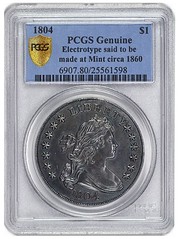 A new type of the 1804 Dollar, which is often referred to as "The King of American Coins," was certified by PCGS at the 2011 American Numismatic Association World's Fair of Money in Chicago on August 19. This is an historic electrotype copy of the unique "Class II" specimen of the 1804 Dollar which is part of the National Numismatic Collection now held by the Smithsonian Institution in Washington, D.C.
A new type of the 1804 Dollar, which is often referred to as "The King of American Coins," was certified by PCGS at the 2011 American Numismatic Association World's Fair of Money in Chicago on August 19. This is an historic electrotype copy of the unique "Class II" specimen of the 1804 Dollar which is part of the National Numismatic Collection now held by the Smithsonian Institution in Washington, D.C.
The unique "1804″ dated silver dollar from which this electrotype has been made was originally struck over an 1857 Swiss Shooting Thaler. Several of the details of the Thaler are visible on the coin, such as the gun stock, parts of the wreath, rays protruding from the cross, border dentils, etc. Some of these details are also visible on the electrotype copy authenticated by PCGS, and the electrotype has a plain edge, just like the unique Class II 1804 Dollar struck over the Swiss Shooting Thaler.
The grading service is calling this piece "Genuine," meaning that it is a genuine electrotype made at the U.S. Mint, rather than a counterfeit made outside the Mint, intended to deceive collectors. This distinction is important! The PCGS label reads, "PCGS Genuine Electrotype said to be made at Mint circa 1860."
The U.S. Mint regularly made electrotype copies of coins between 1860 and 1880 for collectors, museums, and their own uses. The Mint sold electrotype copies of important coins, and it often traded coins or electrotype copies of coins for other coins the Mint did not have in its collection.
The significance of the electrotype 1804 Dollar just certified by PCGS is that it is considered an historic U.S. Mint product, one that represents a rare coin of the greatest numismatic importance. It is not a reproduction of just any coin used for daily commerce. But, it is nevertheless controversial.
The history of this piece is what makes it so important. It's conceivable that someone would be willing to pay in excess of a million dollars to own this electrotype because of its history. The current owner values this piece of history at par with the rare proof dollars of 1801, 1802 and 1803, at which the electrotypes of 1804 traded during the late 1800s and early 1900s.
This electrotype is now owned by ANA Past President H. Robert Campbell who purchased it about 15 years ago from another Past President of the ANA, Kenneth Bressett, who obtained it in 1993 from the Detroit Money Museum. The museum displayed this electrotype from 1960 to 1993 after acquiring it from Detroit collector Nate S. Shapero.
The piece has an elongated light area on its reverse from a display stand used to exhibit it at the Detroit museum. It was first sold at auction on July 25, 1883 by William Jenks, a well-known numismatist from Philadelphia, for which it was the first specimen to be photographed.
The certification of this electrotype reproduction of an 1804 Dollar is controversial to say the least. Before PCGS certified the piece, several noted experts met to examine it and make the determination whether to encapsulate it. It is doubtful that PCGS would certify just any electrotype. This one is important because it was undoubtedly made at the U.S. Mint in Philadelphia. It is an historic piece of monumental importance!
To read the complete article, see:
New Type of 1804 Dollar Certified by PCGS at 2011 ANA Convention
(www.coinweek.com/news/coin-grading/new-type-of-
1804-dollar-certified-by-pcgs-at-2011-ana-convention/)
THE BOOK BAZARRE
BUSINESSWEEK ARTICLE ON THE 1933 DOUBLE EAGLE
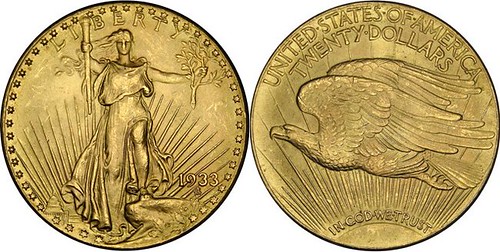
The most valuable coin in the world sits in the lobby of the Federal Reserve Bank of New York in lower Manhattan. It's Exhibit 18E, secured in a bulletproof glass case with an alarm system and an armed guard nearby. The 1933 Double Eagle, considered one of the rarest and most beautiful coins in America, has a face value of $20—and a market value of $7.6 million. It was among the last batch of gold coins ever minted by the U.S. government. The coins were never issued; most of the nearly 500,000 cast were melted down to bullion in 1937.
Most, but not all. Some of the coins slipped out of the Philadelphia Mint before then. No one knows for sure exactly how they got out or even how many got out. The U.S. Secret Service, responsible for protecting the nation's currency, has been pursuing them for nearly 70 years, through 13 Administrations and 12 different directors. The investigation has spanned three continents and involved some of the most famous coin collectors in the world, a confidential informant, a playboy king, and a sting operation at the Waldorf Astoria in Manhattan. It has inspired two novels, two nonfiction books, and a television documentary. And much of it has centered around a coin dealer, dead since 1990, whose shop is still open in South Philadelphia, run by his 82-year-old daughter.
"The government has been fanatical about seizing and destroying these coins," says Robert W. Hoge, curator of North American coins and currency at the American Numismatic Society. "They're famous because the government has been seizing them since the 1940s."
The first phase of the Secret Service investigation would trace 10 1933 Double Eagles to Switt, a reclusive jeweler and coin dealer who, like so many in this story, believed the coins possessed talismanic powers. His only child, Joan Langbord, who worked with him until his death in 1990 at age 95, told the Philadelphia Inquirer that her father "could be obnoxious or irascible. If he didn't like you, he'd throw you out." His business philosophy, she said, was that "the customer was never right; he was always right."
"You must understand the Philadelphia thing," says Brahin. "I'm from there, so I can say this: The dealers were crafty, they would do anything to get an edge. If you don't know that, you don't have the right amount of cynicism to analyze the story."
Fenton bought the Double Eagle for $210,000 and arranged to sell it to an American dealer named Jasper Parrino for $850,000. On Feb. 7, 1996, Fenton flew from London to New York on the Concorde and checked into the Hilton. The next morning, he recalls, he tucked the coin into a plastic envelope, put it in his shirt pocket, pulled on a new black cashmere sweater, and hopped into a taxi to the Waldorf Astoria. "It was a routine deal," he says.
He went up to a corner suite on the 22nd floor and presented the coin to Parrino, who had already arranged to sell it to Jack Moore, a dealer from Texas, for $1.65 million. Moore had brought along a coin expert of his own. As this expert examined the coin, Fenton began to suspect trouble. "His hands were shaking quite a lot," says Fenton. "I thought he might try to steal it. I was afraid someone was going to come bursting into the room with guns. Well, they did."
Moore had contacted the Secret Service and helped them set up an undercover operation. Fenton and Parrino were thrown to the floor by gun-wielding agents who had been waiting in the room next door. "I had an out-of-body experience," says Fenton. "I felt like I was on top of the wardrobe watching. It was like a movie. Then the coin just vanished."
This July, eight years after the Langbords say they found the coins, the trial to get them back began at a Philadelphia courthouse, just blocks from the family store on Jewelers Row.
Joan Langbord, dressed simply in a tan pantsuit and costume jewelry, took the stand the morning of July 19. She was occasionally teary. She was also sharp-minded, plain-spoken, and slightly irritated. Describing the store, she said: "It looks like a junk shop. But expensive junk. It looks the way it did when my father ran it. His chair is still in the store." Only the first floor of the four-story building is open to those who walk in off the street.
Records introduced at the trial show she had visited the safe deposit box many times between 1996 and her discovery of the coins in 2003—including the day before the Sotheby's auction. She said she made the visits to select pieces of her mother's jewelry to sell to a longtime customer and that she never noticed the Wanamaker bag at the bottom. It was only when the box warped and had to be drilled open, she said, that she realized the coins were there. The safe deposit box was shown at the trial: It was about the size of a violin case.
After Langbord testified, the judge called for a lunch break, and she and her other son, David, went to the store. It's still called I. Switt & Ed Silver, though her name and that of her business partner are also in gold letters on the front door. She walked in briskly and got right on the phone about a business matter, pointedly ignoring visitors. The old wood and glass counters were filled with jewelry, silver candlesticks, watches, figurines. A cash register from the 1930s sat on another counter. Yellowing family photos hung askew on the wall next to a 2009 Philadelphia Inquirer article about the gold coins.
The article says the coins have " inspired two novels, two nonfiction books, and a television documentary." I'm aware of the nonfiction books by Frankel and Tripp, but can anyone tell us about the nonfiction books? And where and when did the documentary air - is it available online? -Editor
The Langbords are expected to appeal the verdict. Meanwhile, more 1933 Double Eagle gold coins may still be hidden away. "There has always been talk of others," says Armen Vartian, the lawyer for the Professional Numismatists Guild. Hoge, the U.S. coin expert, says: "It's not impossible that more are out there. I haven't seen them. But it wouldn't surprise me."
To read the complete article, see:
Gold Coins: The Mystery of the Double Eagle
(www.businessweek.com/magazine/gold-coins-the-mystery
-of-the-double-eagle-08252011.html)
DICK JOHNSON: ALUMINIZED-STEEL NOT A VIABLE CENT ALLOY
David L. Ganz had a long article in New York Times last week proffering his idea in solution to the cent problem. It cost more than a cent for the Mint to make a cent in copper coated zinc, the cent's current composition. His solution -- strike the cent in aluminum coated steel.
This is impractical for four reasons.
But he overlooks the most important factor of all. The cent is no longer a viable denomination in the economic scheme of current commerce. The world's economies have advanced beyond the need for a coin of this low demonization. We no longer strike a half cent coin -- or need a plastic mill (Dave mentioned in his Times article) -- because these coin denominations are unfeasible. Like it or not, Dave, we no longer need a cent, for the same reasons of these abolished denominations.
The best evidence to refute Dave's insistence to retain the cent, but strike it in a cheaper alloy, is an article that also appeared this week. Entitled "The Priest and the Unloved Coins," this article reports that Italians, as well as other Europeans, no longer use cent coins. If citizens don't throw them away, they put them in the church collection boxes. But Priests don't want the coins either.
It is estimated five billion Euros in low value coins are idle -- no one wants them. European merchants are rounding, up and down, to prohibit having to use the coins.
Dave states eliminating the cent would result in higher prices. But this has not proved the case in countries that have already eliminated the cent.
Here are the four reasons:
1) Australia and New Zealand were the first to eliminate their cent coin. Prices were rounded off, up or down, to nearest available coin. No problem. Australians abolished their two lowest denominations and are now considering the elimination of the third!
2) Not all merchants always round up. A drug chain in Israel always rounded down, advertised this as their policy, and gained a competitive advantage over their competitors.
3) Even if merchants didn't round down, it would cost the average family less than $100 a year, a Pennsylvania university study revealed.
4) But if the Mint struck coins in Dave's suggested alloy it would create a scrap nightmare! Dave overlooked the fact that at the end of a coin's life as a circulating coin its metal must be reused, converted into a useable form. Separating the aluminum from iron is costly to yield metals not worth the cost of such processing. In contrast, the present copper-coated zinc is easily converted to brass in a cost-effective process.
Believe me, I am not anti-cent, anti-Lincoln, anti-Brenner or against the cent for any reason. I have written in praise of all three, but I recognize the cent denomination is doomed. At least in American like it has been eliminated in other countries. Americans who want to retain the cent do so for sentimental reasons. But that is costing us millions. Abolish the cent coin, don't strike it in a cheaper alloy.
Dave's article:
www.nytimes.com/2011/08/21/opinion/sunday/
can-we-make-the-penny-affordable.html
The Priest's article:
www.corriere.it/english/11_agosto_24/priest-and
-unloved-coins_40f0a0e8-ce3a-11e0-8a66-993e65ed8a4d.shtml
To read the earlier E-Sylum article, see: ALTERNATIVE COMPOSITIONS FOR U.S. COINS SOUGHT (www.coinbooks.org/esylum_v14n35a14.html)
WAYNE'S NUMISMATIC DIARY: AUGUST 28, 2011
First, I should note a major error in an aside in last week's diary, where wrote that I'd met Walter Breen at the 1996 Portland ANA convention. As you'll see from reader comments, that didn't happen.
Michael Schmidt writes:
That 1996 encounter with Walter must have been unusual considering by that time he had been dead for three years.
David Lange writes:
The Portland convention was in 1998, and Walter Breen had died five years earlier. Perhaps, it was at the 1990 Seattle convention that you encountered him in need of directions.
I was planning to fact check the date when I wrote that, but forgot to get back to it. Since it's not important to the story, we'll just delete that reference from the archive version. Sorry! I think Dave is right, though - it was probably the 1990 Seattle show.
This week I'll begin by picking up on last week's notes on my visit to the American Numismatic Association's convention in Chicago, a.k.a the World's Fair of Money. First, responses to my Quick Quiz. About this picture of Dave Harper & Bob Van Ryzin at the Krause Publications table, I asked, "who are the two gentlemen seated behind Dave & Bob?"
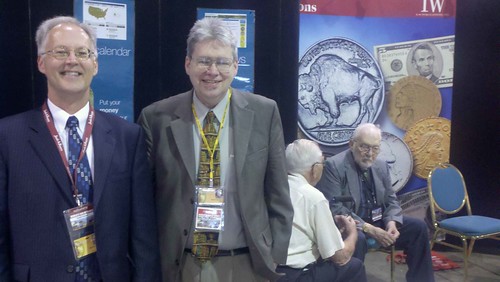
Correct answer: Chester Krause and Alan Herbert. Thanks to both Joe Boling and Neil Shafer.
Responding to my note about pencils, Joe Boling adds:
I carry a mechanical pencil all the time, and use it to record price, source, and date in all book purchases - in approximately 8-point lettering.
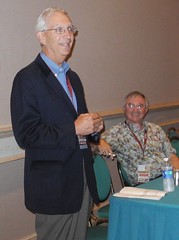 Dave Bowers forwarded these photos of the NBS Annual meeting last Friday. Here's outgoing president Dan Hamelberg speaking with Treasurer David Sundman seated behind. Below are two nice panoramic shots of the audience, taken shortly before I arrived.
Dave Bowers forwarded these photos of the NBS Annual meeting last Friday. Here's outgoing president Dan Hamelberg speaking with Treasurer David Sundman seated behind. Below are two nice panoramic shots of the audience, taken shortly before I arrived.


2011 NBS Annual Meeting
I mentioned last week how Brad Karoleff knelt before Joel Orosz and Len Augsburger in an "I'm not worthy to be in your presence!" position in honor of their NLG Book of the Year award for The Secret History of the First U.S. Mint. Len managed to get this shot.
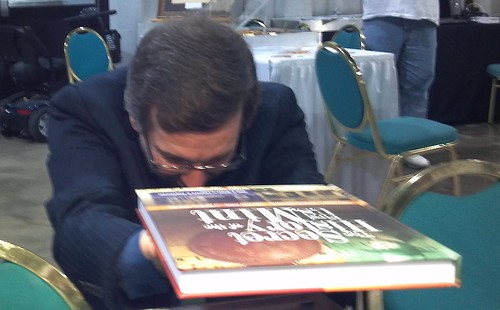
Brad Karoleff in supplication to Len and Joel
About 2pm everyone began gathering outside the convention hall for the trip to see Bill Burd's library. From left to right are Fred Reed, Tom Sheehan, David Sklow, Myron Xenos, Pete Smith, Darryl Xenos, and Elizabeth Hahn. When I introduced Fred Reed to Bill, I somehow managed to follow the word "Fred" with "Schwan". I quickly corrected myself, and we laughed it off. It had been years since I'd seen him in person, although we correspond by email regularly.
Earlier we'd talked about my column in the TAMS Journal and his upcoming book on Civil War postage stamp envelopes, a favorite collectible area of mine. I recalled first learning about them while visiting the ANA Library in 1980, reading an old American Journal of Numismatic article by H. Russell Drowne. That was about all that had been written on them at the time, and I'm looking forward to Fred's thorough book-length treatment.
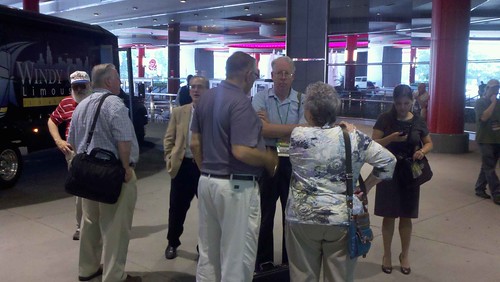
Attendees Gather for the Burd Numismatic Library Tour
The bus ride was fun, albeit long. Chicago traffic and a less-than-optimal route chosen by our driver made for a slow journey. But everyone had fun conversing. Howard Berlin was already on the bus when I got on. We'd never met in person before, and he'd wanted to meet up with me at the show. I sat across from him in the front row. We talked about his upcoming "Numismatourist" book and a quotation about museums. His book recounts his journeys to numismatic museums and mints around the world. He had spent time at the show talking with representatives at the various world mint booths making contacts for future visits.
Behind me were Amanda Harvey and David Sklow. Across from David were Myron and Darryl Xenos. We talked a bit about Armand Champa's "Invasion of Louisville" library tour. I wondered what ever became of the video Armand had someone record of the day's events. Both David and Myron seemed to think they might have a copy. Hopefully it will turn up.
Somehow we got to talking about book packaging and shipping. Myron often uses old U.S. postage stamps, which can be had at a good discount from face value. Now there's a collectible "investment" gone bad. Bill Burd noted that it's hard to even give away sheets of small denomination stamps like one or two-centers. It takes so many to add up to the proper postage that they're hard to actually use. Some post offices restrict their use to just the front of the package. Others allow mailers to plaster all sides of the box with stamps.
We talked about numismatic literature dealer John Bergman, who is the Godfather of Proper Packing Procedures for shipping numismatic literature. He wrote a great Asylum article on the topic and even had a special business card illustrating how to pack a book. Protect those corners!
David Sklow told us about going to his post office to pick up boxes containing Q. David Bowers' research library consignment. Bowers staffers who packed the boxes marked many of them "Heavy". Others were marked "Very Heavy". Don't ask about the ones marked "Wicked Heavy". Not even the post office staff would touch them. Sklow had to go in the back and retrieve them himself.
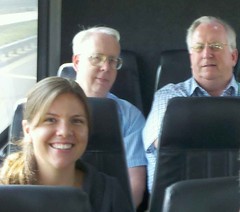 I was out of earshot for the other conversations, but there were plenty of them.
I looked back and noticed that Elizabeth Hahn had drawn the short straw and was sitting alone.
I pointed my camera and got some smiles out of everyone. Here's Elizabeth with Pete Smith and Tom Sheehan behind.
I was out of earshot for the other conversations, but there were plenty of them.
I looked back and noticed that Elizabeth Hahn had drawn the short straw and was sitting alone.
I pointed my camera and got some smiles out of everyone. Here's Elizabeth with Pete Smith and Tom Sheehan behind.
Once there we all signed a guest book, then fanned out to look at books. It was a comfortable, spacious facility, beautifully accented with artwork, and framed numismatic items. Many of the items were odd and curious monies.
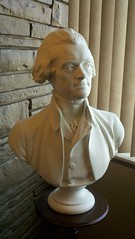
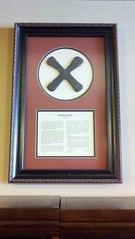
Richard Thompson and his son had driven separately but arrived shortly after we all did. I spoke to them for a bit about collecting numismatic literature.
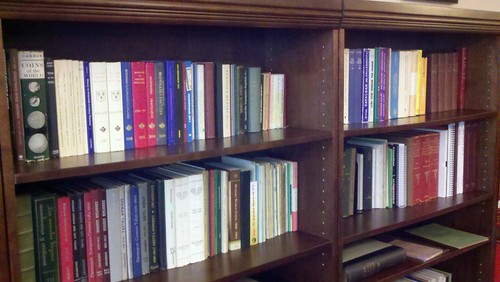
I spent a lot of time leafing through Bill's numismatic ephemera. Like me, he has these housed in binders in archival sleeves. Every numismatic library has something not seen anywhere else, and I was not disappointed. I've got LOTS of ephemera, but Bill had a number of items I'd never seen before. Many were related to the Chicago Coin Club, but there were also some B. Max Mehl items I hadn't seen.
I helped myself to the tasty meatballs and other hors d'oeuvres. OK, I had a couple cookies, too. And two glasses of wine, without spilling a drop. Bill was an incredibly generous and gracious host. We couldn't have had a better time - it was bibliophile heaven.
At one point someone asked for a pencil. I reached into my handy Man Purse (aka backpack) and pulled one out. I guess I do keep one of everything in there.
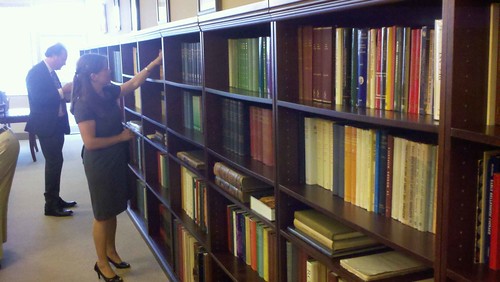
Eventually 5:30 rolled around and it was time to reboard the bus. Several of us had to get to the ANA Banquet beginning at seven. The return trip was much faster. I moved around a bit, first to sit with Fred Reed, then with Elizabeth. We talked about Civil War numismatics, Armand Champa, the new ANS HQ, and her interest in marine archeology.
Back at the convention center we all thanks Bill Burd and said our goodbyes. It was a perfectly marvelous trip. Thanks again, Bill!
I headed back to my room to suit up for the banquet. I would be joining Dennis Tucker at the Whitman table. I ran into Myron and Darryl in the elevator and we gradually figured out the signage and found our way to the reception. After the wine I'd had that afternoon I didn't need any more, but bought a soft drink to nurse for a while.
The reception was already crowded when we arrived, and most of it is a blur in my memory. So many friends, so little time! I talked with Fred Schwan and told him about blurting out his name by mistake when introducing Fred Reed earlier.
George Cuhaj came by and I teased him about his facial hair, saying he looked a bit like Colonel Sanders. Later I ran into Bob Van Ryzin and he was wearing a different tie this time.
Barbara Gregory stopped to talk and I told her about mistaking Christine for her the day before. Say, is that early Altzheimer's kicking in? But I learned I wasn't the first to make that mistake. She told me about plans to publish my article on George Rode, an unsung pioneer of the American Numismatic Association and its conventions.
So many great people! I saw Gene Hessler and Mark Anderson but didn't get a chance to talk. The room was chockablock with numismatic personalities from all across the country. I hadn't made it far across the room when I met a smiling young man with blond hair and asked him what he collected. AU Morgan dollars, it turned out. Fred Schwan was nearby again, and the two of us chatted with him for a while. I asked his name and learned it was John Bowers. Yeah, THAT Bowers - he must get that a lot at coin conventions. Little did I realize I'd be sharing a banquet table with him and his grandfather, Dave Bowers. Here's a picture courtesy of John Wilson.
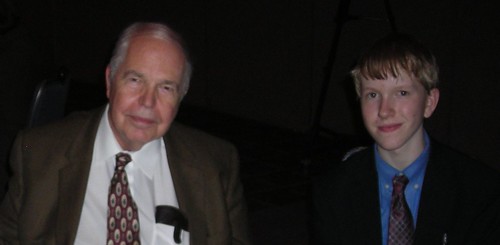
Dave and John Bowers at the 2011 ANA Banquet
I'd been looking for Dennis Tucker ever since I arrived. No luck. When they opened the doors to the dining room I wandered around looking for the Whitman table. I saw Richard Jewell and Tom Uram from the Pittsburgh area and chatted a bit. Both are members of the Sphinx Society, the group I modeled my Northern Virginia numismatic social group Numis Nova after. I invited them to come join us sometime. We meet on the night before Sphinx.
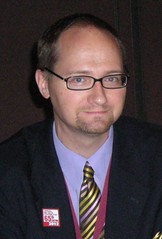 Eventually I found the Whitman table. Dennis arrived and we were seated just as MC Wendell Wolka started the program. Here's another shot of Dennis courtesy of John Wilson. I cropped it into a nice, dignified head shot.
But if I'd wanted an undignified bunny-ears shot I couldn't have done better than this accidental snapshot where the waiter carrying plates behind Dennis makes it look like he has Dumbo-sized saucer ears. (Sorry, Dennis - I couldn't resist. Remember, you're a Good Sport). Next to Dennis was Jeff Garrett - I'm sorry we didn't get much of a chance to converse.
Eventually I found the Whitman table. Dennis arrived and we were seated just as MC Wendell Wolka started the program. Here's another shot of Dennis courtesy of John Wilson. I cropped it into a nice, dignified head shot.
But if I'd wanted an undignified bunny-ears shot I couldn't have done better than this accidental snapshot where the waiter carrying plates behind Dennis makes it look like he has Dumbo-sized saucer ears. (Sorry, Dennis - I couldn't resist. Remember, you're a Good Sport). Next to Dennis was Jeff Garrett - I'm sorry we didn't get much of a chance to converse.
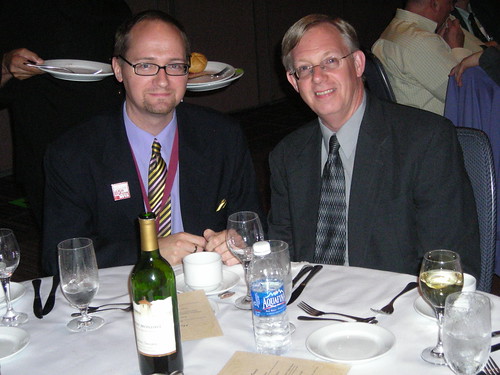
Dennis Tucker and Wayne Homren at the 2011 ANA Banquet
After the banquet I followed Dennis and David Crenshaw to the Hyatt bar. We were quickly joined by David Lange. We had a great conversation on multiple topics including Lange's books and the coin publishing business in general. I pulled out my Smartphone and showed Dave Lange what I'd been reading while waiting for my plane to take off - an e-book version of his book on the U.S. Mint I'd downloaded from Amazon for $9.99.
In the next booth were Tom Hallenbeck and Mike Ellis. On the way out Tom stopped me to thank me for all my work on The E-Sylum. It was past midnight by then, and I dragged myself up to my room for the night.
Saturday morning came early. I really hated to have to miss the Rittenhouse Society breakfast, but I needed to get home - it was my son Tyler's 11th birthday. The flight was uneventful and I arrived at the Pizza-Go-Round place back in Virginia just in time for his birthday lunch. He and his siblings, along with two neighbor boys, played game after game in the arcade. Tyler begged over and over for more money to feed the machines, and I gave in every time. It ended up being worth it - he came away with some great prizes from the grab-it machine. I was exhausted, but glad to be home.
Nothing much happened of note Sunday and Monday, but Tuesday was a different story. Shortly before 2pm I was sitting at my desk trying to get some work done when I heard a low rumble, like someone was rolling a heavy cart down the hallway or on the floor above. But it got louder and I wondered what it really was. Then the entire building began to rattle and shake. I saw window frames and posts jiggling before my eyes. In a few seconds it was over. My coworkers were looking out the window to see what had happened.
I feared I might see plumes of smoke from a plane crash or a crater from a car bomb. Lampposts in the parking lot were still swaying, and people began streaming out of the building. But no smoke, no flames - nothing else out of the ordinary except for the crowd filling the parking lot. We realized it had been an earthquake. People in the East aren't used to these. News reports called it a 5.8, the strongest felt in the area in a century.
We checked around and the only damage in the office was a framed poster that had fallen from what was a precarious perch in the first place. The glass hadn't broken. One of the guys had been in a bathroom stall when it happened, confirming that the stall walls shook a great deal. I told him, "that'll cure your constipation!" We laughed it all off nervously, still wondering if we should stay or go.
My office is in Maryland. I called my wife down in Virginia and learned the quake was felt there, too. She missed it though - she was probably walking outside at the time, and only learned about it when she and our daughter got into her doctor's office for a checkup. My son Christopher was home with his grandmother. They were in the basement and the house shook quite a bit. But no damage.
Bibliophiles will be glad to know my library was unharmed. I'm just glad my library didn't harm anything else. My wife isn't keen on my books in the first place, and would like them even less if they were strewn across the floor, or had say, killed the dog. But Max was fine, too.
I sent a quick email to my sister and learned she'd felt it all the way up in Pittsburgh. I shot a note to Alan Weinberg in L.A., figuring he'd have something to say about us wimpy East coasters who don't know what a REAL earthquake is. Californians stir their morning coffee with a 5.8. He wrote:
That's just George Washington turning over in his grave over what the Federal Gov't has turned into.
Later in the day I saw this Internet photo labeled "DC Earthquake Devastation".
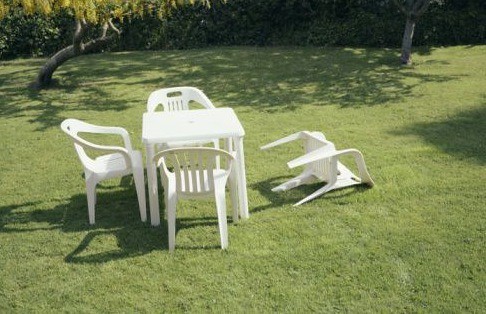
But not everything went unscathed. The Washington Monument is closed indefinitely - new cracks were found in a helicopter inspection. Spires on the National Cathedral fell off. The White House, Capitol and other government buildings were evacuated. Everyone in my building was told to go home as well. But it was like trying to get home after the 4th of July Fireworks. It took me twenty minutes just to get out of my parking space, and nearly 1 1/2 hours to get out of the parking lot. What a mess. Luckily I was able to get home around 6pm and join my family for dinner at a local restaurant. Here's hoping it's another hundred years before we see a quake that size around here.
A seismic event of another sort happened that evening. While watching our kids play outside I got an emailed press release from the American Numismatic Association. Executive Director Larry Shepherd had been placed on administrative leave by the new board. The action had taken place on Saturday, after I'd already left the show. Here we go again - this will be another interesting chapter in the history of the organization's troubled leadership ranks.
Wednesday August 24th was my birthday, and my Facebook page filled up with birthday greetings from near and far. Here are just a few samples. Thanks, everyone!
"Have yourself a downright bibliophilic birthday, Wayne!"
"Happy Birthday awesome book dude!"
"Already? I just HB'd you lately, I thought. You should slow down!"
"A special edition of the NBS newsletter is needed just to list all the people wishing Wayne, "Happy Birthday!""
My birthday turned out to be special for an unexpected reason. My wife's nephew rushed his wife to the hospital in labor. Around noon her great nephew Aiden William was born. Another August 24th birthday in the family! She packed up our kids, her parents and Max the Dog and drove up to Pittsburgh to see the baby. I was already at work and was on my own for my birthday. But they came back the next day and on Friday we had dinner and some cake to celebrate.
Having gotten thru the earthquake I had to spend Friday evening after dinner making preparations for a hurricane. Hurricane Irene was bearing down on the east coast, and was set to hit near Washington over the weekend. I was bringing furniture in from our deck when I got a phone call. It was the secretary of an E-Sylum reader who was looking for more information on the Type II Quint offered for sale by Bill Burd.
Phone calls from readers are rare - I think I've only fielded a couple in all the years of publishing The E-Sylum. I didn't ask, but she avoided telling me her boss' name. But at least one of you is interested in the piece. I passed along what I could remember and after hanging up I continued with my work. I think I told her the piece was slabbed by NGC, but in fact it was PCGS. I get everything backwards if I'm away from my computer where I can check. I offered to answer any questions or forward any notes to Bill Burd via email, but I haven't heard any more from this reader.
Well, Hurricane Irene turned out to be a non-event in our neighborhood. We had a lot of wind and rain Saturday night, but no damage, thankfully.
The only other sort-of numismatic news is that my son Tyler is getting a collecting bug - for Pokemon cards. I bought some on his behalf through eBay, but more importantly (to me) we also sold some duplicates for very good money. He's sold four cards for a total of $33. We posted one for sale this morning and it was sold by lunchtime. We were having lunch at McDonald's when I got the news on my phone. He was excited. I think he may have a knack for collectible marketing and promotion. But first he has to get back to school, which starts here tomorrow morning - not a day too soon for my wife, who's had her fill of all three of them this summer.
Well. that's it for this week's Numismatic Diary. Thanks for coming along on the adventure.
CONGRATULATIONS TO RICK TOMASKA!
THE ORDER OF THE STRIPED TIGER
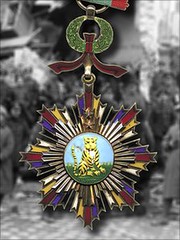 A medal awarded to a courageous Presbyterian missionary is to be auctioned in Hong Kong later this week.
A medal awarded to a courageous Presbyterian missionary is to be auctioned in Hong Kong later this week.
The silver-gilt and enamel Order of the Striped Tiger decoration was awarded to Dr Frederick O'Neill for his work as chaplain to the Chinese Labour Corps in France during World War I.
Dr O'Neill, a native of Dungannon, County Tyrone, was 27 when he was sent by the Irish Presbyterian Church to Manchuria in north-east China in 1897.
He and his wife, also a Presbyterian missionary, were to survive several periods of conflict during their stay in the country.
One of his descendants provided some details of the missionary's career in pre-Communist China.
He revealed that Dr O'Neill, a fluent Chinese speaker, went unmolested in 1900 during the Boxer Revolution which opposed foreign imperialism and Christianity.
Dr O'Neill retired to east Belfast where he died, aged 82, in 1952.
His Order of the Striped Tiger decoration will be auctioned in Hong Kong on Thursday by numismatist specialists Baldwins.
It is estimated to fetch US $5,000-$6,000.
To read the complete article, see: Tyrone missionary's Chinese medal to be auctioned (www.bbc.co.uk/news/uk-northern-ireland-14615360)
THE PRIEST AND THE UNLOVED COINS
At Atella, a municipality of 3,800 residents in the province of Potenza, it's the talk of the town. Last Sunday, Fr Domenico Traversi, the parish priest of the 14th-century church of Santa Maria ad Nives, said from the pulpit how frustrating it was to open a collection box and find handfuls of one and two-cent coins. "I throw them away", he is reported to have said. "No one uses them".
The story ended up on the pages of the Gazzetta del Mezzogiorno, along with reports that the nearest greengrocer had taken the advice to heart and rounded up all his prices. Now Fr Domenico is furious. He says his outburst has been misinterpreted and promises letters to clarify the situation but he also admits: "No, I don't throw the coins away. But I can't pay €3,000 for the new electrical equipment the diocese wants installed in one-cent coins".
The copper eurocents are one of Italy's many contradictions. No one uses them. When you get some in your change, they just weigh down your pockets, unless you pop them into the church collection box. Yet Italy is swamped with – useless – eurocents. Since 2002, the Italian mint has struck 6.7 billion coins in the three smallest denominations. There are 2.6 billion one-cent coins, 2.2 billion worth two cents and 1.9 billion five-cent coins. The huge face value of about €165 million represents about 45% of the euro coinage struck for the ministry of the economy.
The tiddlers have had a tough time from the start. On 22 January 2002, a few days before the new currency went into circulation, Giulio Tremonti, the economy minister in the second Berlusconi administration, announced: "Doing away with eurocents would undoubtedly be a popular move. We're thinking it over and we've discussed it in the European Union". At the time, economist Giacomo Vaciago predicted that the copper-clad steel coins would have a lifespan measurable in months yet here they still are, in our trouser pockets, handbags and collection boxes.
The first Italians to do away with small coins were the managers of the Senate catering facilities, who on 1 February 2002 opted to go one better than Mr Tremonti and immediately abolish the pointless European small change: cappuccinos were reduced from 67 cents to 65 and croissants fell from 46 to 45 while filled rolls leapt from €1.14 to €1.20.
To read the complete article, see:
The Priest and the Unloved Coins
(www.corriere.it/International/english/articoli/2011/08/24/
priest-and-unloved-coins.shtml)
ARTICLE HIGHLIGHTS SAN FRANCISCO HOTEL'S MONEY LAUNDERER
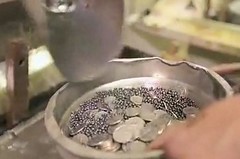 In a secret back room of a San Francisco hotel wired with fiber optic cable, one man still practices a tradition leftover from the 1930s: cleaning money.
In a secret back room of a San Francisco hotel wired with fiber optic cable, one man still practices a tradition leftover from the 1930s: cleaning money.
Rob Holsen is the coin washer at the Westin St. Francis Hotel, and perhaps the only coin washer on Earth.
He said the hotel on Union Square started washing its coins in 1934 when the general manager noticed a woman's white gloves getting dirty. Now, nearly 80 years later, the tradition somehow survives.
"I once gave an FBI agent my card that says 'coin washer' on it," Holsen said. "And I told her we laundered money, at which point she reached for her hip."
Most of the coins Holsen cleans come from the front desk and restaurants in the hotel. The washing process takes about seven hours.
First the coins are sorted by denomination, then a washing machine tumbles the coins around in a mixture of buckshot, soap and water.
"Basically you've made a meringue out of soap and water instead of egg whites," he said. "Then you have to put your hands in this black goo."
After the coins dry, Holsen rolls them and puts them back into circulation.
Holsen has been working at the hotel for 30 years. After 20 years as a coin washer, he thinks he has cleaned about $1.5 million in coins.
For security reasons, Holsen has to go through four different locks to get to the coin washing room. The last lock opens "the magic door with no writing on it," he said. Even most employees at the hotel don't know where the room is.
To read the complete article, see:
Coin Washer Cleans SF Hotel's Money
(www.nbcbayarea.com/news/weird/Coin-Washer-Cleans
-SF-Hotels-Money-128219193.html)
THE ORIGIN OF THE TREVI FOUNTAIN COIN TRADITION
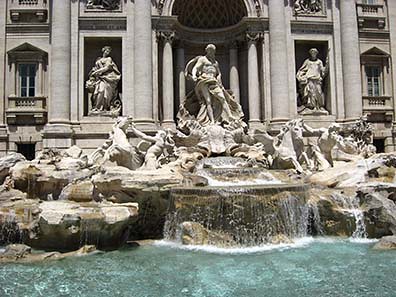
A coin thrown in Trevi Fountain is said to ensure the comeback to Rome, two coins thrown ensure romance with a Roman (either male or female), and three coins thrown ensure the marriage with him or her. This is demonstrated in the film "Three coins in the fountain" from 1954 telling the story of three young ladies working in the American Embassy in Rome who throw a coin in the fountain in order to find love.
One coin for coming back to Rome – this is how we were trained, this is what thousands of tourists do each day when standing at Trevi Fountain. Revenues of this superstitious act add up to 600,000 Euros each year for Roman authorities.
This habit actually dates back to the 19th century, and it was founded, who would have guessed, by a German. Back then, Rome was the desired destination for many middle-class travelers who could afford a vacation. Many of these visited archaeologist Wolfgang Helbig (1839-1915), who worked as a private scholar and, most of all, as a dealer in antiquities in Rome (in fact, some modern authors assign him credits for one of the other particularly good forgery). In 1862, he had come to Rome as beneficiary of the German Archaeological Institute and soon got himself a permanent position there. The marriage with Russian princess Nadejda Schakowskoy enabled him to retire from service.
His wife brought him into contact with the sophisticated society for which he hosted jamborees. During one of these festivities he introduced the habit of throwing coins in Trevi Fountain. Most possibly he was inspired by the ancient sacrifices for bridge and spring deities. Travelers, especially from the Celtic and Roman cultural spheres, used to perform sacrifices to the deities residing in a stream. Tourists from Germany loved this custom that aligned themselves with their ancient predecessors. Their travel reports, letters and stories spread it in entire Europe, of course without crediting its inventor. He was almost entirely forgotten (except for archaeologists who still use his guide to the public collections of Classical antiquities in Rome). Up to the present day, some a tour guide presents the German invention as an old Italian folk custom.
To read the complete article, see: Coins in the fountain well: Trevi Fountain in Rome (www.coinsweekly.com/en/Article-of-the-week/5)
FEATURED WEB PAGE: EARLY QUARTER DOLLARS OF THE UNITED STATES 1796-1838
This week's Featured Web Page is the NBS Bibliography page on Browning's EARLY QUARTER DOLLARS OF THE UNITED STATES 1796-1838."The most perfect numismatic book written on the first try," per Walter Breen, Browning was little known for its time, a labor of love which reached print but not much further. Today the original Browning and the Ford 1950s reprint are highly prized, with a combined print run of perhaps one hundred copies. Breen's opinion notwithstanding, Browning's work is dedicated to the quarter dollar die varieties of 1796 to 1837 and not much else. Ironically, it was Breen himself who did much to expand the definition of numismatics beyond mere technical data. Thus, although Browning was well written and well plated, today's collectors expect more. Happily, the efforts of Steve Tompkins have recently resulted in a complete update of Browning, a four hundred page cornucopia of quarters. In full color with considerable commentary not found in Browning, Tompkins is now the reference of choice for the bust quarter collector. For the bibliomaniac, one can only recommend that both are acquired, not to mention the precursor work, Haseltine's Type Table (#95).
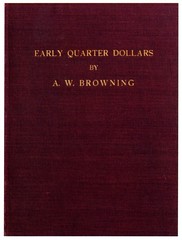
EARLY QUARTER DOLLARS OF THE UNITED STATES 1796-1838
